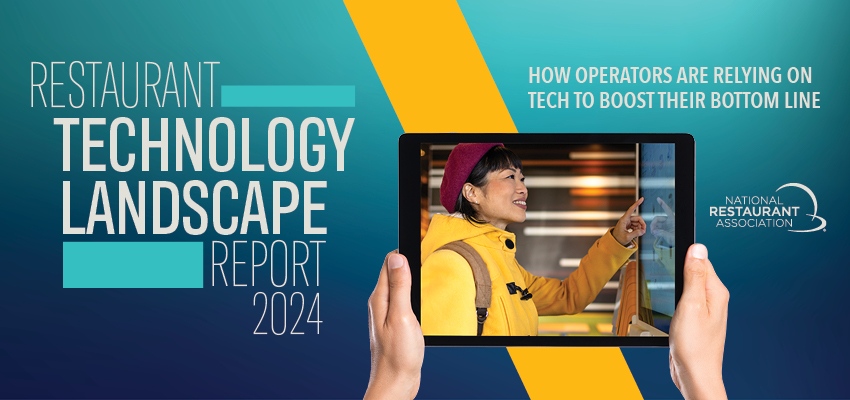Articles
October 15, 2024
Restaurateurs use tech to manage inventory, save money
Inventory management systems automate tedious and time-consuming procedures, giving you greater control over costs.

A good inventory management system should provide detailed reporting on cost of goods sold, waste tracking, and usage trends over time.
Any restaurant operator who has experienced a power outage, a failed compressor on a walk-in refrigerator, or a flood in a storeroom knows that what’s on those shelves isn’t simply food and supplies, it’s money. Manage your inventory poorly and you can lose money on a daily basis due to spoilage, theft, waste, over- or under-ordering, and hours of employee time.
If you’re a small, independent operator, you likely manage inventory by hand, ordering product based on a visual assessment of what’s on the shelves and what’s needed to meet weekly projections. You probably take inventory once a month (reluctantly, because it’s a huge chore) to keep tabs on what you have and to calculate your food cost. A month, however, is enough time for a host of costly problems to develop.
“A good inventory management system should provide detailed reporting on cost of goods sold, waste tracking, and usage trends over time,”” says Lauren Noreen, senior product marketing manager, Back Office, a Buyers Edge Platform brand, Littleton, Colo. “It should support recipe management by calculating ingredient costs based on current prices and tracking variances between actual and theoretical inventory levels. These insights help identify inefficiencies, control costs, and maximize profitability.”
Inventory management systems track inventory in real time, letting you know instantly when stock is getting low. They also automate tedious tasks such as generating purchase orders, entering invoices, and forecasting inventory needs. When integrated with your POS system, inventory management systems also can generate food cost reports and food use reports, helping you track comps and food waste, and identify potential theft.
Types of systems
Most inventory management systems now are cloud-based apps or software programs available on a subscription basis. They range in cost from free for the simplest systems to several hundred dollars per month for sophisticated systems designed for multi-unit operators. Most systems designed for independent restaurants cost about $100 per month or less.
Common features include:
IM systems don’t automate everything, and it takes some initial work to set up the system. When set up properly, however, IM systems make controlling your food costs and managing your inventory a walk in the park. Even taking weekly inventory (instead of monthly) becomes a breeze.
First, organize and label your walk-in and storeroom shelves, giving appropriate space to every ingredient on your menu. Next, create sheets that list each labeled slot, the ingredient that occupies it, and the unit of measurement used to quantify it, such as “cases,” “lbs.,” or “pieces.” Recognize that you’ll likely have different slots for the same product using different units of measurement. For example, you may inventory frozen French fries by the case in the walk-in freezer, by the 5-lb. bag in the reach-in freezer, as “each” in 6-oz. pre-portioned bags in a refrigerated drawer on the line, and by the ounce loose in a pan in the same drawer.
Keeping product in designated spots makes taking inventory simple. It also means products will be easier to find during a rush, and makes it easier to see when inventory may be disappearing faster than it should due to waste, comps or theft.
What to look for
There are dozens of service providers. The key to finding a system that works well in your operation is to prioritize your needs and what you want an IM system to do. Here are some factors to consider.
IM systems hold managers and staff accountable and teach them how you, and they, make money. With better control of your inventory and a better idea of how much you actually have on hand and need at any given time, you won’t have to order as much. Less food on your shelves keeps your walk-in and storeroom cleaner and more organized (great for health inspections), makes it easier to find things, speeds inventory taking, makes employees more careful about how they use product so they don’t run out, and ultimately gives you more cash on hand to pay bills, offer bonuses, or reinvest in the business.
The nominal investment for an IM system will pay for itself many times over in cost savings from inventory lost to waste, spoilage, theft, or too many comps.
If you’re a small, independent operator, you likely manage inventory by hand, ordering product based on a visual assessment of what’s on the shelves and what’s needed to meet weekly projections. You probably take inventory once a month (reluctantly, because it’s a huge chore) to keep tabs on what you have and to calculate your food cost. A month, however, is enough time for a host of costly problems to develop.
“A good inventory management system should provide detailed reporting on cost of goods sold, waste tracking, and usage trends over time,”” says Lauren Noreen, senior product marketing manager, Back Office, a Buyers Edge Platform brand, Littleton, Colo. “It should support recipe management by calculating ingredient costs based on current prices and tracking variances between actual and theoretical inventory levels. These insights help identify inefficiencies, control costs, and maximize profitability.”
Inventory management systems track inventory in real time, letting you know instantly when stock is getting low. They also automate tedious tasks such as generating purchase orders, entering invoices, and forecasting inventory needs. When integrated with your POS system, inventory management systems also can generate food cost reports and food use reports, helping you track comps and food waste, and identify potential theft.
Types of systems
Most inventory management systems now are cloud-based apps or software programs available on a subscription basis. They range in cost from free for the simplest systems to several hundred dollars per month for sophisticated systems designed for multi-unit operators. Most systems designed for independent restaurants cost about $100 per month or less.
Common features include:
- Real-time tracking. Inventory is automatically adjusted based on sales.
- Integration with POS systems. Systems can be tied into your POS system, making inventory tracking that much more accurate.
- Recipe costing. Each item on your menu can be broken down into recipe component costs, allowing the system to track inventory of all ingredients down to the teaspoon, including your house-made sauces, soups, gravies, etc.
- Ordering and purchasing integration. The system can automatically generate purchase orders and contact the supplier directly, and provide updates on supplier delivery times.
- Alerts and notifications. Systems alert you to low inventory, perishable inventory that’s approaching use-by dates, and unanticipated usage patterns.
- Reports and analytics. IM systems can use the data to analyze different performance metrics and issue reports on variances between actual and theoretical product/ingredient usage, cost of goods sold, waste tracking, voids and comps (by employee), and more.
- Supplier coordination. Electronic data interface (EDI) links to suppliers let you send purchase orders directly to suppliers, pay bills, get pricing updates and notifications on special deals, and alerts on delivery times.
- Security and user permissions. This allows multi-unit operators to give unit managers and others the ability to use the system.
- QR code menu and inventory scanning. More and more restaurants are using digital menus. QR codes can be integrated into the IM system, and some systems let you scan invoices to automatically enter the items listed into inventory.
IM systems don’t automate everything, and it takes some initial work to set up the system. When set up properly, however, IM systems make controlling your food costs and managing your inventory a walk in the park. Even taking weekly inventory (instead of monthly) becomes a breeze.
First, organize and label your walk-in and storeroom shelves, giving appropriate space to every ingredient on your menu. Next, create sheets that list each labeled slot, the ingredient that occupies it, and the unit of measurement used to quantify it, such as “cases,” “lbs.,” or “pieces.” Recognize that you’ll likely have different slots for the same product using different units of measurement. For example, you may inventory frozen French fries by the case in the walk-in freezer, by the 5-lb. bag in the reach-in freezer, as “each” in 6-oz. pre-portioned bags in a refrigerated drawer on the line, and by the ounce loose in a pan in the same drawer.
Keeping product in designated spots makes taking inventory simple. It also means products will be easier to find during a rush, and makes it easier to see when inventory may be disappearing faster than it should due to waste, comps or theft.
What to look for
There are dozens of service providers. The key to finding a system that works well in your operation is to prioritize your needs and what you want an IM system to do. Here are some factors to consider.
- Ease of use
- Mobile app or stand-alone software, and phone/computer system requirements
- Integration with your POS system
- Ingredient-level inventory tracking
- Bar-specific inventory features if you have liquor service
- Low-stock alerts
- Perishables tracking
- Recipe ingredient costing and cookbook features
- Sales-based forecasting reports
- Par-based reorder reports
- Automated purchase order generation
- Supplier EDI connections
- Real-time vendor price updates
- Automated invoice entry
- Automated stock updates
- Food cost reports and cost control suggestions (e.g., alternative ingredients)
- Loss and theft reports
- Waste tracking
- Labor cost tracking
- Integration with your accounting system
- Free demos or free versions
- Availability of the provider’s customer service department
- Free and unlimited staff training
- Subscription cost per plan tier
IM systems hold managers and staff accountable and teach them how you, and they, make money. With better control of your inventory and a better idea of how much you actually have on hand and need at any given time, you won’t have to order as much. Less food on your shelves keeps your walk-in and storeroom cleaner and more organized (great for health inspections), makes it easier to find things, speeds inventory taking, makes employees more careful about how they use product so they don’t run out, and ultimately gives you more cash on hand to pay bills, offer bonuses, or reinvest in the business.
The nominal investment for an IM system will pay for itself many times over in cost savings from inventory lost to waste, spoilage, theft, or too many comps.
Gold Sponsor
-
Samsung DisplayAs a global technology leader, the Samsung Display Division is committed to helping customers realize the promise of a digital business with a diverse portfolio of enterprise technologies including Smart Signage, LED Screens, Video walls, and Monitors. Samsung puts the customer at the core of everything we do by delivering comprehensive products, solutions and services across diverse industries. For more information, please visit samsung.com/business.Learn More
Download the report
Download the report
Sign up for our Newsletter
The latest news from the National Restaurant Association, published every other Thursday
By clicking Submit I agree to receive email communications from the National Restaurant Association and agree to our Privacy Policy(Opens in a new window).

